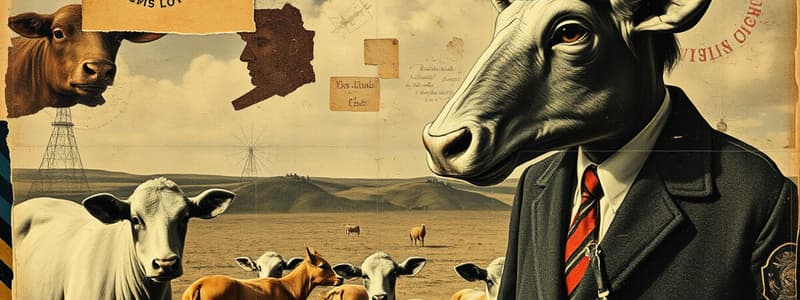Podcast
Questions and Answers
Old Major symbolizes which of the following figures?
Old Major symbolizes which of the following figures?
- Joseph Stalin
- Leon Trotsky
- Vladimir Lenin (correct)
- Karl Marx (correct)
Who does Napoleon symbolize?
Who does Napoleon symbolize?
Stalin
Snowball symbolizes which historical figure?
Snowball symbolizes which historical figure?
Trotsky
What does Squealer represent?
What does Squealer represent?
What does Minimus represent in Animal Farm?
What does Minimus represent in Animal Farm?
Boxer symbolizes which social group?
Boxer symbolizes which social group?
Clover symbolizes which group?
Clover symbolizes which group?
Who does Mollie symbolize?
Who does Mollie symbolize?
What does Benjamin represent?
What does Benjamin represent?
The dogs symbolize which group in the context of Animal Farm?
The dogs symbolize which group in the context of Animal Farm?
What does Moses symbolize?
What does Moses symbolize?
The sheep represent which type of citizens?
The sheep represent which type of citizens?
Mr. Jones symbolizes which historical figure?
Mr. Jones symbolizes which historical figure?
Who does Frederick symbolize?
Who does Frederick symbolize?
What does Pilkington represent?
What does Pilkington represent?
Whymper symbolizes which group?
Whymper symbolizes which group?
Flashcards are hidden until you start studying
Study Notes
Character Symbolism in Animal Farm
- Old Major: Represents Karl Marx and Vladimir Lenin, key figures in the development of Communism, signaling the ideological foundation for the rebellion.
- Napoleon: Symbolizes Joseph Stalin, the leader of the Soviet Union, who ruled with an iron fist and executed various purges during his time in power.
- Snowball: Represents Leon Trotsky, a prominent revolutionary leader who was exiled and later assassinated on Stalin's orders, reflecting the struggle for power within the Communist party.
- Squealer: Embodies the Soviet press, illustrating how media was manipulated by Stalin to spread propaganda and control public perception.
- Minimus: A pig who crafts propaganda poems, symbolizing the use of art as a tool for totalitarian control and the shaping of citizens' beliefs.
- Boxer: Represents the male working class and peasants, embodying the hardworking yet exploited labor force that supported the revolutionary ideals but ultimately faced betrayal.
- Clover: Symbolizes the female working class and peasant women, highlighting their role and struggles within the Soviet society.
- Mollie: Represents the self-serving, materialistic middle class, illustrating those who prioritized personal comfort over collective good during a time of revolution.
- Benjamin: Symbolizes the skeptical and detached individuals who recognized the oppressive regime but remained inactive, criticizing passivity in the face of injustice.
- The Dogs: Represent the Soviet secret police, showcasing the violent enforcement of the regime's power and the suppression of dissent.
- Moses: Symbolizes organized religion, reflecting its role in providing comfort and a promise of a better life beyond the hardships of the current world.
- The Sheep: Represent the unthinking masses that follow totalitarian leaders blindly, depicting the dangers of indoctrination.
- Mr. Jones: Symbolizes the Russian Tsar, illustrating the oppressive rule that catalyzed the revolution and the liberation movements in early 20th century Russia.
- Frederick: Represents Fascist Germany, highlighting the external threats and conflicts that emerged during the period of totalitarian rule.
- Pilkington: Symbolizes the Western Allies, particularly the British, who had varied relationships with the Soviet regime before World War II.
- Whymper: Represents capitalists who profited from dealings with the USSR, emphasizing the complexities of international business and political relationships during this era.
Studying That Suits You
Use AI to generate personalized quizzes and flashcards to suit your learning preferences.




